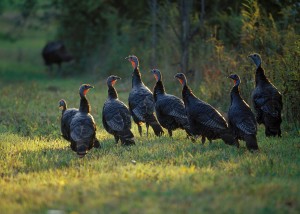An estimated 50,000 hunters will take to the woods during the upcoming turkey season, generating an estimated $30 million in direct expenditures for South Carolina’s economy.
Legislation passed by the S.C. General Assembly last year sets new season dates and bag limits on private lands. Season dates for private lands are now March 20 to May 5 statewide. For all Wildlife Management Areas (WMAs) where turkey hunting is allowed the season will continue to open on April 1 as it traditionally has, but will close on May 5. The statewide bag limit is now three gobblers per hunter with no more than two taken in one day.
Hunters on WMAs should consult the annual Rules & Regulations guide for seasons and bag limits on specific WMAs as they may be more restrictive.
Saturday and Sunday, March 12-13, are Youth Turkey Hunt Days on private lands statewide. On WMA lands open to turkey hunting the Youth Turkey Hunt Day is Saturday, March 26. On these days, youths 17 and under who are accompanied by a properly licensed adult (age 21 and older) may hunt turkeys. Although adults may call or guide, only the youth can take or attempt to take turkeys. There is no license requirement for youths, however, tagging requirements and bag limits remain in place for these special youth days.
The outlook for the 2016 spring season is only fair for most areas, according to Charles Ruth, Deer and Wild Turkey Program coordinator for S.C. Department of Natural Resources (DNR). This is based on recent turkey harvest and reproductive trends. Annually since the early 1980s, DNR conducts a Summer Turkey Survey to estimate reproduction and recruitment of turkeys in South Carolina. The survey involves agency wildlife biologists, technicians and conservation officers, as well as many volunteers from other natural resource agencies and the general public.
“Reproduction in turkeys has generally been low for the last decade,” said Ruth. “This year, average brood size of 3.6 poults remained good, but the total recruitment ratio of 1.5 was low, continuing a less than desirable trend. This low figure was driven by a high percentage of hens (59 percent) that had no poults at all by late summer. Recruitment ratio has averaged 1.7 over the last five years; keep in mind that 2.0 is somewhat of a break-even mark. In fact, when turkey populations were expanding during the 1980s, recruitment ratio averaged 3.5. Recruitment ratio is a measure of young entering the population based on the number of hens in the population.”
What does low reproduction mean for the spring turkey hunter? Ruth said, “Given recent harvest trends, which have followed trends in reproduction very closely, the expectation for 2016 is only fair. That said, the harvest should increase slightly over 2015 because there were fewer 2-year-old birds last year as a result of the all-time low reproduction in 2013. Two-year-old gobblers comprise most of the harvest because they are typically more abundant and more responsive to hunters’ calls than older, more dominant gobblers. Although not great, reproduction in 2014 increased a little, which was evidenced by the increase in the harvest of jakes last year. Therefore, if trends hold, there should be more 2-year-old birds during spring 2016.”
Also, the gobbler-to-hen ratio during last summer’s survey was 0.50, which is the lowest since the year 2000, according to Ruth. Low gobbler-to-hen ratios can affect the quality of hunting because hens are extremely available, which affects gobbling and responsiveness to calling by hunters.
“The bottom line,” Ruth said, “is the state’s turkey population is about 35 percent below record levels around the turn of the century. We need better reproduction for several years to get the population back up. That is the nice thing about turkeys, though; given the right conditions they can naturally bounce back in a short period of time.”
For more information on wild turkeys, including how to order turkey tags online, the 2016 Turkey Regulations, the 2015 Summer Turkey Survey or the results from the 2015 spring gobbler season, see the following link on the DNR Web site: www.dnr.sc.gov/wildlife/turkey/index.html.


